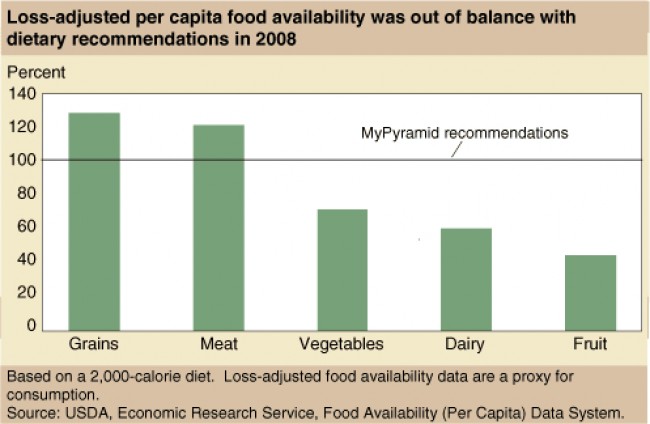 The above chart, created by the USDA, compares the food consumed by the average U.S. citizen (using “loss-adjusted food availability” data as a proxy for consumption) to Federal dietary recommendations. In other words, what Americans eat vs. what the federal government thinks we should be eating.
The above chart, created by the USDA, compares the food consumed by the average U.S. citizen (using “loss-adjusted food availability” data as a proxy for consumption) to Federal dietary recommendations. In other words, what Americans eat vs. what the federal government thinks we should be eating.
According to this analysis, we eat something like 30 percent more grain than we should–presumably mainly in the form of bread–and 20 percent too much meat. Meanwhile, we’re eating just 80 percent of the vegetables we should be, 60 percent of the dairy, and 40 percent of the fruit.
Another way to put it is like this: from a dietary perspective, we’re overproducing (and consuming) wheat and meat, and underproducing (and consuming) fruits and vegetables.
There are many ways to interpret this information. One is to read it as a pure reflection of consumer preference: Americans like bread and meat; fruit and veg, not so much–nanny-state nattering by government dietitians be damned.
But the dietitians have a point. Excess meat consumption appears to be pretty bad for you –particularly pork and beef. And the dietary recommendations aren’t exactly skimpy on meat.
And, of course, dietitians aside, the federal government has facilitated the the abundant availability of meat in a variety of ways–through massive subsidies of livestock feed crops like corn and soy, by looking the the other way as meat packers consolidated and drove down the price of meat, and by allowing meat packers to externalize public-health costs and environmental costs, and keep labor costs to a minimum at expense of worker safety.
In short, the net effect of federal policy has been to encourage the public’s appetite for meat, by creating an environment in which cheap meat thrives.
Perhaps the time has come to change that–to create policies that force food enterprises to pay for their messes; ensure that a few large entities don’t wield sufficient market power to dictate conditions on farms; and encourage a diversity of crops–with an emphasis on fruits and vegetables.



